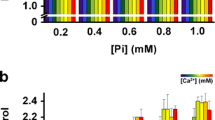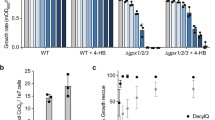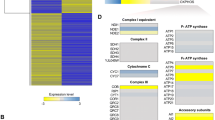Abstract
Ubiquinone derivatives modulate the mammalian mitochondrial Permeability Transition Pore (PTP). Yeast mitochondria harbor a similar structure: the respiration- and ATP-induced Saccharomyces cerevisiae Mitochondrial Unselective Channel ( Sc MUC). Here we show that decylubiquinone, a well-characterized inhibitor of the PTP, suppresses Sc MUC opening in diverse strains and independently of respiratory chain modulation or redox-state. We also found that naturally occurring derivatives such as hexaprenyl and decaprenyl ubiquinones lacked effects on the Sc MUC. The PTP-inactive ubiquinone 5 (Ub5) promoted the Sc MUC-independent activation of the respiratory chain in most strains tested. In an industrial strain however, Ub5 blocked the protection elicited by dUb. The results indicate the presence of a ubiquinone-binding site in the Sc MUC.





Similar content being viewed by others
Abbreviations
- dUb:
-
Decylubiquinone
- dVO4 :
-
Decavanadate
- Δψ:
-
Mitochondrial transmembrane potential
- FCCP:
-
Carbonyl cyanide p-trifluoro-methoxyphenyl-hydrazone
- Cyclosporine A:
-
CsA
- PTP:
-
Mitochondrial permeability transition pore
- Sc MUC:
-
Saccharomyces cerevisiae mitochondrial unselective channel
- Ub5 :
-
Ubiquinone 5
- Ub30 :
-
Hexaprenylquinone
- Ub50 :
-
Decaprenylquinone
References
Akerman KE, Wikström MK (1976) Safranine as a probe of the mitochondrial membrane potential. FEBS Lett 68:191–197
Azzolin L, Von Stockum S, Basso E et al (2010) The mitochondrial permeability transition from yeast to mammals. FEBS Lett 584:2504–2509
Basso E, Fante L, Fowlkes J et al (2005) Properties of the permeability transition pore in mitochondria devoid of Cyclophilin D. J Biol Chem 280:18558–18561
Bernardi P (2013) The mitochondrial permeability transition pore: a mystery solved? Front Physiol 4:95
Bernardi P, Von Stockum S (2012) The permeability transition pore as a Ca2+ release channel: new answers to an old question. Cell Calcium 52:22–27
Bonora M, Bononi A, De Marchi E et al (2013) Role of the c subunit of the FO ATP synthase in mitochondrial permeability transition. Cell Cycle 12:674–683
Bonora M, Wieckowski MR, Chinopoulos C, et al. (2014) Molecular mechanisms of cell death: central implication of ATP synthase in mitochondrial permeability transition. Oncogene. doi:doi:10.1038/onc.2014.96
Bradshaw PC, Pfeiffer DR (2013) Characterization of the respiration-induced yeast mitochondrial permeability transition pore. Yeast 30:471–483
Brenner C, Moulin M (2012) Physiological roles of the permeability transition pore. Circ Res 111:1237–1247
Carraro M, Giorgio V, Sileikytė J, et al. (2014) Channel Formation by Yeast F-ATP Synthase and the Role of Dimerization in the Mitochondrial Permeability Transition. J Biol Chem 289:15980–15985
Castrejón V, Peña A, Uribe S (2002) Closure of the yeast mitochondria unselective channel (YMUC) unmasks a Mg2+ and quinine sensitive K+ uptake pathway in Saccharomyces cerevisiae. J Bioenerg Biomembr 34:299–306
Cortés P, Castrejón V, Sampedro JG, Uribe S (2000) Interactions of arsenate, sulfate and phosphate with yeast mitochondria. Biochim Biophys Acta 1456:67–76
de Kloet S, van Wermeskerken R, Koningsberger VV (1961) Studies on protein synthesis by protoplasts of Saccharomyces carlsbergensis. I. The effect of ribonuclease on protein synthesis. Biochim Biophys Acta 47:138–143
Devun F, Walter L, Belliere J et al (2010) Ubiquinone analogs: a mitochondrial permeability transition pore-dependent pathway to selective cell death. PLoS ONE 5:e11792
Díaz-Ruiz R, Averet N, Araiza D, Pinson B, Uribe-Carvajal S, Devin A et al (2008) Mitochondrial oxidative phosphorylation is regulated by fructose 1,6-bisphosphate. A possible role in Crabtree effect induction? J Biol Chem 283:26948–26955
Di Lisa F, Bernardi P (2006) Mitochondria and ischemia-reperfusion injury of the heart: fixing a hole. Cardiovasc Res 70:191–199
Di Lisa F, Carpi A, Giorgio V, Bernardi P (2011) The mitochondrial permeability transition pore and cyclophilin D in cardioprotection. Biochim Biophys Acta 1813:1316–1322
Fontaine E, Eriksson O, Ichas F, Bernardi P (1998) Regulation of the permeability transition pore in skeletal muscle mitochondria. Modulation By electron flow through the respiratory chain complex I. J Biol Chem 273:12662–12668
Giorgio V, Soriano ME, Basso E et al (2010) Cyclophilin D in mitochondrial pathophysiology. Biochim Biophys Acta 1797:1113–1118
Giorgio V, Von Stockum S, Antoniel M et al (2013) Dimers of mitochondrial ATP synthase form the permeability transition pore. Proc Natl Acad Sci U S A 110:5887–5892
Gutiérrez-Aguilar M, Douglas DL, Gibson AK et al (2014) Genetic manipulation of the cardiac mitochondrial phosphate carrier does not affect permeability transition. J Mol Cell Cardiol 72:316–325
Gutiérrez-Aguilar M, Pérez-Martínez X, Chávez E, Uribe-Carvajal S (2010) In Saccharomyces cerevisiae, the phosphate carrier is a component of the mitochondrial unselective channel. Arch Biochem Biophys 494:184–191
Hunter DR, Haworth RA (1979) The Ca2+-induced membrane transition in mitochondria. I. The protective mechanisms. Arch Biochem Biophys 195:453–459
Ichas F, Mazat JP (1998) From calcium signaling to cell death: two conformations for the mitochondrial permeability transition pore. Switching from low- to high-conductance state. Biochim Biophys Acta 1366:33–50
James AM, Cochemé HM, Smith RAJ, Murphy MP (2005) Interactions of mitochondria-targeted and untargeted ubiquinones with the mitochondrial respiratory chain and reactive oxygen species. Implications for the use of exogenous ubiquinones as therapies and experimental tools. J Biol Chem 280:21295–21312
Kwong JQ, Davis J, Baines CP et al (2014) Genetic deletion of the mitochondrial phosphate carrier desensitizes the mitochondrial permeability transition pore and causes cardiomyopathy. Cell Death Differ 21(8):1209–1217
Leverve XM, Fontaine E (2001) Role of substrates in the regulation of mitochondrial function in situ. IUBMB Life 52(3–5):221–229
Li B, Chauvin C, De Paulis D et al (2012) Inhibition of complex I regulates the mitochondrial permeability transition through a phosphate-sensitive inhibitory site masked by cyclophilin D. Biochim Biophys Acta 1817:1628–1634
Manon S (1999) Dependence of yeast mitochondrial unselective channel activity on the respiratory chain. Biochim Biophys Acta 1410:85–90
Manon S, Roucou X, Guérin M et al (1998) Characterization of the yeast mitochondria unselective channel: a counterpart to the mammalian permeability transition pore? J Bioenerg Biomembr 30:419–429
Prieto S, Bouillaud F, Rial E (1995) The mechanism for the ATP-induced uncoupling of respiration in mitochondria of the yeast Saccharomyces cerevisiae. Biochem J 307(Pt 3):657–661
Quinlan CL, Peresvoshchikova IV, Hey-Mogensen M, Orr AL, Brand MD (2013) Sites of reactive oxygen species generation by mitochondria oxidizing different substrates. Redox Biol 1:304–312
Uribe S, Rangel P, Pardo JP (1992) Interactions of calcium with yeast mitochondria. Cell Calcium 13:211–217
Uribe-Carvajal S, Luévano-Martínez LA, Guerrero-Castillo S et al (2011) Mitochondrial unselective channels throughout the eukaryotic domain. Mitochondrion 11:382–390
Varela C, Cárdenas J, Melo F, Agosin E (2005) Quantitative analysis of wine yeast gene expression profiles under winemaking conditions. Yeast 22:369–383
Walter L, Miyoshi H, Leverve X et al (2002) Regulation of the mitochondrial permeability transition pore by ubiquinone analogs. a progress report. Free Radic Res 36:405–412
Walter L, Nogueira V, Leverve X et al (2000) Three classes of ubiquinone analogs regulate the mitochondrial permeability transition pore through a common site. J Biol Chem 275:29521–29527
Yamada A, Yamamoto T, Yoshimura Y et al (2009) Ca2+-induced permeability transition can be observed even in yeast mitochondria under optimized experimental conditions. Biochim Biophys Acta 1787:1486–1491
Acknowledgments
M.G.-A. is currently supported by an American Heart Association Midwest Affiliate Postdoctoral Fellowship (13POST14060013). HLC is a CONACyT fellow enrolled in the Ms. Sc. Biochemistry program at UNAM. CUA, EGS and MRL are CONACyT fellows enrolled in the Ph. D. Biochemistry program at UNAM. Partially funded by DGAPA/PAPIIT Project IN202612. We acknowledge the technical assistance of Ramón Mendez. Mariana Valenzuela kindly helped to build the figures.
Author information
Authors and Affiliations
Corresponding author
Rights and permissions
About this article
Cite this article
Gutiérrez-Aguilar, M., López-Carbajal, H.M., Uribe-Alvarez, C. et al. Effects of ubiquinone derivatives on the mitochondrial unselective channel of Saccharomyces cerevisiae . J Bioenerg Biomembr 46, 519–527 (2014). https://doi.org/10.1007/s10863-014-9595-3
Received:
Accepted:
Published:
Issue Date:
DOI: https://doi.org/10.1007/s10863-014-9595-3




